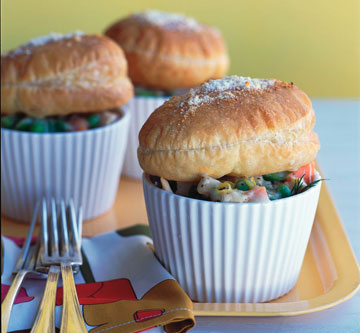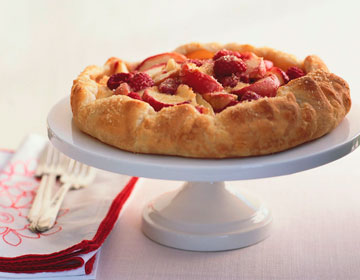 |
Now
KOF-K Dairy Kosher Originating in France, Puff Pastry dough is often referred to as Pâte Feuilletée or leafed pastry because it has many leaves or layers. Puff pastry is the finest of doughs. It is crisp, buttery, flaky and especially light. Puff Pastry makes a perfect wrapping for a variety of savory and sweet dishes. Our Puff Pastry dough is made with care and love, by first enclosing a "butter block" in the dough, which is then folded and rolled out numerous times to create hundreds of alternating thin layers of pastry and butter. Puff Pastry expands when baked, rising to about 8-times its original height; so a quarter-inch thickness of puff pastry dough will puff up to 2 inches high! Inside the “puff” are hundreds of flaky and thin layers, that push the dough upwards and outwards in all directions. You will love our Puff Pastry Dough ! Available in Food service and Retail. |
Many of our products both foodservice and retail have been formulated with natural ingredients for use in natural food stores. Please contact us for more details. |
|
| PRODUCT | ITEM | CASE COUNT | GROSS WT. |
| CLASSIC ALL-BUTTER (94 score AA churned sweet) |
11" x 11"x 1/4 " | 6 Sheets | 10# |
| 11" x 16" x 1/8" | 12 Sheets | 10# | |
| Bulk | 2 - 15# wads | 30# | |
| CHOCOLATE (94 score AA churned sweet butter) |
|||
| 11" x 16" x 1/8 " | 12 Sheets | 10# | |
| Bulk | 2 - 15# wads | 30# | |
| PATE BRISEE / PIE DOUGH | 11" x 16" x 1/8 " | 12 Sheets | 10# |
| VOL-AU-VENTS | |||
| 3 1/2 " | 100 | 12# | |
|
Recipes
• Ham, Gruyère, and Dijon Palmiers
• Roasted Chicken Potpie with Spring Vegetables • Gingery Nectarine Berry Galette
|
|
|
Ham, Gruyère, and Dijon Palmiers Makes 48 hors d’oeuvres These hors d’oeuvres are flaky, chewy, and impossibly good with a chilled glass of riesling. The palmier (PAHL me yay) is a classic shape in French pastry that’s easy to form and that shows off fillings beautifully. Here, I layer mustard, ham, and Gruyère cheese with the pastry, so the flavors are classic, too. Get the ham sliced very thinly at the deli counter. If the ham falls apart a bit, that’s okay; you can piece it together as you assemble the palmiers. 1 sheet (about 9 ounces) frozen puff pastry, thawed2 tablespoons Dijon mustard 3 ounces (about 1 cup) grated aged Gruyère cheese 1/4 cup (1/2 ounce) freshly and finely grated Parmesan cheese 4 ounces very thinly sliced good-quality baked ham, such as Black Forest Position the sheet of pastry on a lightly floured counter so that a short side is closest to you. Roll the pastry into a 10-by-14-inch rectangle. Trim the edges, if necessary, to make the rectangle neat. Using the back of a spoon or an offset spatula, spread the mustard over the pastry. Distribute the Gruyère and Parmesan evenly over the surface. Arrange the ham in a single even layer, tearing or cutting pieces to fit. Lay a piece of parchment paper or waxed paper on top and gently compress the layers with the rolling pin. Peel off the paper without disturbing the ham. Cut the rectangle in half widthwise to make two 10-by-7-inch bands. With your fingers, gently roll one long edge of one of the bands into the center and then roll the opposite edge in so the two rolls meet in the middle and resemble a double scroll. Press lightly so the rolls stick together (spread a few drops of water where the two rolls meet to help them stick, if you need to). Repeat with the second band. Wrap the rolls in plastic and chill in until they firm up, at least an hour the refrigerator or 30 minutes in the freezer. When you’re ready to bake, heat the oven to 425 degrees F and line two baking sheets with parchment paper or a silicone baking mat (or use nonstick baking sheets). With a very sharp knife, slice each roll into 24 pieces, arrange them on a sheet at least 1 inch apart, and bake until the pastry is nicely browned and flaky (break one apart to be sure it’s not still doughy in the center), and the cheese is melty but not burned, 10 to 12 minutes. If your oven doesn’t heat evenly, swap the pans’ positions halfway through cooking. Transfer the palmiers to a cooling rack. Serve just slightly warm or within the hour, if possible. Do ahead You can assemble the rolls to the point just before slicing and freeze them for up to one month. To refresh any leftovers, reheat them in a 350-degree F oven for 5 to 7 minutes.  Roasted Chicken Potpie with Spring Vegetables Serves 4 to 6 Though we all have fond childhood memories of frozen chicken potpie (well, I do anyway), white-meat chicken in a pasty white sauce isn’t all that appealing to grown-ups. This version brings the true rich, savory flavor of roast chicken to a potpie. I use chicken legs or thighs here because dark meat has indisputably more flavor than breast meat, and the moist texture is perfect in a sauce. I call for a mix of “spring” vegetables, but use what feels seasonal: mushrooms in fall, mixed root vegetables in winter, squash and peppers in summer. This recipe uses a neat trick to avoid the potpie pitfall of underdone pastry in the middle of the pie: cutting the pastry to the size of the dish, baking it separately until almost finished, then transferring it to the chicken stew in the potpie dish to finish cooking, which marries the crust to the sauce without sogginess. 2 1/4 pounds chicken thighs or whole legsKosher salt and freshly ground pepper 4 cups low-sodium chicken broth 3 medium carrots (about 7 ounces total), peeled and cut into 1/2-inch dice, to yield about 1 cup 12 ounces asparagus (about 18 spears), woody ends trimmed, cut into 1-inch pieces 2 tablespoon chicken fat or unsalted butter 1/4 cup all-purpose flour 3 tablespoons chopped mixed fresh tender herbs (I like a mix of parsley, dill, and chives) 1/2 teaspoon lightly packed finely grated lemon zest Fresh lemon juice, to taste 1 sheet (about 9 ounces) frozen puff pastry, thawed 1 cup fresh or frozen peas (no need to thaw) Heavy cream for brushing the pastry (optional) 2 tablespoons freshly and finely grated Parmesan cheese, for dusting the pastry (optional) Heat the oven to 400 degrees F. Season the chicken generously with salt and pepper and arrange in a single layer in a heavy flameproof pan, such as a large skillet or small roasting pan. Roast the chicken until tender and the juices run clear, or it registers 175 degrees F on an instant-read thermometer, about 45 minutes. Transfer the chicken to a plate and let it cool until you can handle it easily. Pour all the fat from the pan into a small bowl. Do not rinse out the pan; the cooked-on juices will be part of the sauce. Meanwhile, put the broth in a medium saucepan and bring it to a boil. Add the carrots and cook until just barely tender, about 3 minutes. Scoop them out with a slotted spoon and set aside. Add the asparagus to the boiling broth and cook for about 30 seconds; scoop out and add to the carrots. Set aside the vegetables and the broth. When the chicken has cooled, pull off the skin (it should be nice and crisp, so enjoy a piece as a snack), cut off the meat, and cut into small pieces. Add to the vegetables. Put the roasting pan over medium heat and add back about 2 tablespoons of the chicken fat (if you don’t have enough, use butter). Add the flour and whisk to make a smooth paste, called a roux. Cook the roux for about 1 minute, whisking constantly, then slowly whisk in the broth to create a smooth sauce. Cook the sauce, whisking frequently, until it’s reduced to about 3 cups, is very smooth, and has the consistency of thick gravy, 10 to 15 minutes. Remove from the heat, add the herbs, lemon zest, lemon juice, and a generous amount of pepper; it will probably be plenty salty, but if not, add more salt. Heat the oven to 400 degrees F. On a lightly floured counter, roll the pastry to the size and shape of the top of your baking dish (at least 1 1/2-quart capacity). Slide the pastry onto a baking sheet and bake until puffed and light brown, about 15 minutes. Meanwhile, fold the vegetables, cooked peas and chicken into the sauce, and simmer gently to heat everything through. When the pastry is ready, scrape the filling into the baking dish, transfer the pastry top to the filling; if you like, brush the top with a little heavy cream and sprinkle with grated Parmesan. Return the potpie to the oven and continue cooking until the filling is hot and the pastry is deep golden brown, another 3 to 4 minutes. Serve immediately. Do ahead You can prepare the chicken, vegetables and sauce one day ahead. Refrigerate the sauce separately.  Gingery Nectarine Berry Galette Makes one 11-inch galette to serve 6 to 8 Peaches are wonderful in this galette as well, but with nectarines there is no need to peel the fruit. You can omit the berries, but they’re pretty and they accent the flavor and texture of the nectarines. This galette shape is so easy and versatile that once you get the hang of it, you can play with all kinds of fruit—apple slices, pear chunks, raspberries, wedges of juicy plum. The small amount of flour will help thicken the juices released by the fruit and keep the galette from getting too soggy; adjust the amount of flour up or down depending on the juiciness of the fruit. 1 sheet (about 9 ounces) frozen puff pastry, thawed1 1/2 pounds ripe nectarines (about 3 large nectarines), pitted and cut into 1/2-inch wedges 1 cup fresh or frozen berries 1 tablespoons granulated sugar, more to taste 2 1/2 tablespoons all-purpose flour 1 teaspoon finely grated fresh ginger 2 tablespoons unsalted butter, 1 tablespoon cut into bits and 1 tablespoon melted 1 tablespoon coarse sugar, such as turbinado or Sugar in the Raw Heat the oven to 400 degrees F. On a lightly floured counter, roll the pastry into a 15-inch square and cut out a 15-inch round; it doesn’t have to be perfect. Slide the round onto a baking sheet (it’s fine if the edges hang over; you’ll be folding them up). In a medium bowl, toss the nectarines and berries with the sugar, flour, and ginger, then pile the fruit onto the pastry round, leaving about a 2-inch border. Fold the edges of the pastry over the fruit, pleating at even intervals as you go around. Distribute the butter bits over the fruit. Bake the galette until the crust is lightly golden brown and the fruit is beginning to bubble, about 20 minutes. Brush the crust with the melted butter, sprinkle with the coarse sugar, and continue baking until the pastry is a rich golden brown, including the underside of the galette, and the fruit is hot and bubbly, another 15 to 25 minutes (depending on how juicy your fruit is). If the crust is browning too fast, turn the oven down to 350 degrees F. Let cool for about 10 minutes before serving. |
|



